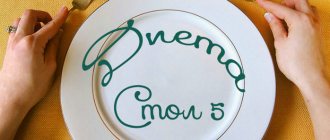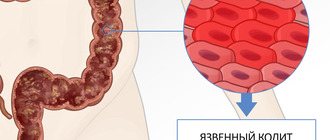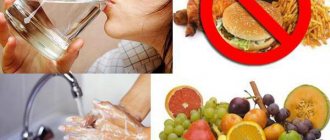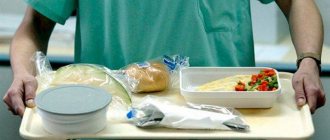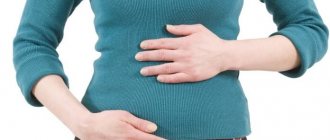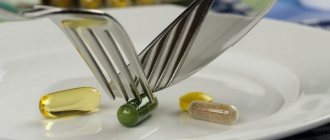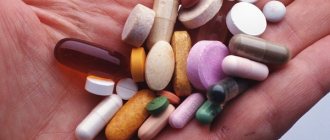Purpose of the diet
A balanced diet and a healthy lifestyle help get rid of many health problems, including gastroduodenitis. This disease is accompanied by such unpleasant gastrointestinal symptoms as:
- Constant heaviness in the stomach.
- Attacks of nausea.
- Heartburn.
- Unpleasant sensations in the abdominal cavity after eating.
- Diarrhea followed by constipation.
A diet for gastroduodenitis relieves such symptoms and helps prevent the development of complications.
Why does the belly grow in the stomach area? causes and symptoms
Shapes of the stomach.
In addition to the amount of food consumed, other factors influence the degree of stomach enlargement:
- chronic fatigue;
- irregular nutrition;
- inflammation in the body;
- constant stress.
Gastric dilatation can occur against the background of:
- Constant overeating. Eating more food than required causes pathological expansion of the organ. This condition can last up to 12 hours due to the need to digest large volumes of food.
- Refusal of breakfast. Having rested from food overnight, the body requires replenishment in the morning. Therefore, breakfasts are very important. This can protect against overeating at lunch and will help avoid ulcers and gastritis due to a long break in food.
- One meal per day with a large amount of food consumed. The regularity of this action is addictive to the stomach. For this reason, the organ begins to slowly digest food and maintain its expanded volume longer.
- Regular consumption of large volumes of liquid. It is better to drink water, tea or other drinks between meals to avoid overstretching the stomach.
- Quick absorption of food without thorough chewing.
- Regular fast food snacks.
All of these reasons cause a gradual change in the volume of the digestive organ. But acute dilatation of the stomach may occur. Hypertrophy in its acute form is characterized by a rapid and intense increase in size against the background of sharp atony (decreased tone) of the organ wall. The causes of acute hypertrophy can be explained:
- Congenital weakness of the muscle tissue of the wall.
- Postoperative complications during abdominal surgery.
- The presence of other diseases, such as injuries to the skull and spine, infectious diseases (typhoid fever), pneumonia, heart attack, chemical and bacterial intoxication, ulcers complicated by stenosis, etc.
Scheme of acute gastric dilatation.
Acute gastric dilatation is characterized by symptoms such as:
- severe pain in the left side of the abdomen;
- swelling in the upper region of the peritoneum, closer to the left side;
- nausea with uncontrollable intense vomiting, the masses of which contain stagnant, undigested products;
- severe hiccups;
- weak thirst.
Due to a severe disturbance of the water-electrolyte balance during hypertrophy, the development of collapse is possible, the symptoms of which are:
- confusion;
- cold and clammy sweat;
- acrocyanosis;
- cold extremities;
- low blood pressure with tachycardia.
When the gastric wall enlarges, neurological signs of hypertrophy appear, such as:
- muscle cramps of the calves, upper limbs and masticatory muscles;
- increased tone and stable resistance of the muscles of the back of the head to deforming forces.
If the stomach enlarges sharply and quickly, serious complications may occur, such as rupture of the organ wall. Hypertrophy is accompanied by severe shock.
When aggressive gastric contents leak, peritonitis develops - severe inflammation of the peritoneum. Less commonly, with hypertrophy, bleeding from the erosive mucous membrane may develop.
With severe distension of the stomach, the anomaly is easy to see without additional symptoms. There will be a noticeable increase in the abdominal area on the left side, closer to the hypochondrium. Hypertrophy can be seen especially clearly in the supine position.
But the initial stages of hypertrophy pass without symptoms. The first signs are often attributed to problems of a different nature. Therefore, if symptoms such as heaviness, nausea, pain in the stomach appear repeatedly, you should urgently consult a doctor.
Principles of nutrition
For the diet to be effective, you need to remember a few basic rules:
- Each piece of food must be chewed thoroughly. Getting unchopped food into the stomach injures the mucous membrane and aggravates the course of the disease.
- Eat at least five times a day in small portions. Try to eat at the same time every day.
- Do not eat excessively cold or hot foods. All food should be warm. Even products stored in the refrigerator, such as fermented milk, must be kept at room temperature for some time before consumption.
- If you cannot imagine your life without sweets, then choose honey. This natural product will not harm the digestive system and will help strengthen the immune system. This will make it easier for the body to cope with the disease.
- Avoid eating fried foods completely. Boil, bake or stew meat and vegetables.
- Choose mineral water as a drink. The specific composition is selected after consultation with a doctor.
By following these recommendations, you can quickly get rid of the disease and not cause harm to your health..
Effective Diets
There are several basic diets designed to treat gastrointestinal diseases. For gastroduodenitis the following are used:
- Table No. 5. Its main task is to protect the liver from damage and increased bile secretion. This diet is based on reducing the consumption of refractory fats. At the same time, the amount of proteins and carbohydrates should remain within normal limits.
- Cooking is allowed only by boiling or baking. If vegetables contain a lot of starch, they are pureed. Eating fatty meats is prohibited: lamb, duck, pork. You can add a little butter or vegetable oil to your dishes.
- You cannot eat fresh bread, baked goods, or pies. Sweets should be replaced with dried fruits, marshmallows or honey.
- You will have to give up a number of dairy products: sour cream, fermented baked milk, cream, milk. They need to be replaced with kefir or yogurt.
- Table No. 1. Diet for gastroduodenitis in the acute stage or during the last phase of treatment. Involves complete abstinence from foods that stimulate secretion in the stomach. Food must be digested quickly, so spices and other irritants are not allowed in it. The use of marinades and smoked meats is prohibited. The daily norm is 1500 kcal.
The choice of a specific diet is made based on the patient's test results. The specialist should give all the necessary recommendations on proper nutrition.
Hormonal imbalances
Our body is a very complex system in which everything is interconnected. And changes in hormonal levels can lead to weight gain. This is the answer to the question of why the belly appears after childbirth and during menopause - the balance of hormones changes.
The same applies to adolescents during puberty. Also, hormonal disorders can be a consequence of disorders of the endocrine system. Thyroid hormones are responsible for the breakdown of fatty acids.
What to do? Initially, check your thyroid gland, get tested for hormones, and consult with medical specialists. It will probably be necessary to optimize your diet.
Choosing a diet depending on the form of the disease
Gastroduodenitis can have various forms and degrees of severity. Depending on them, the specialist selects a specific nutrition program.
The following varieties are distinguished:
- Diet for acute illness. The provoking factor is the consumption of fatty foods, alcohol, and dry food. Therefore, first of all, it is necessary to exclude harmful foods from the diet. Forget about smoked foods, canned foods, and carbonated drinks. In the first couple of days, it is better to completely forget about food. Try to drink more herbal teas or rosehip infusion. After that, stick to a gentle menu.
- Diet for chronic gastroduodenitis. The key to effective treatment will be a warm drink. Eat small meals. Completely eliminate ingredients that irritate the surface of the stomach, for example, spices, sauces, smoked foods, mushrooms. Do not eat pearl barley and millet cereals. It is better not to eat raw vegetables. Eat them stewed or steamed.
- Diet for gastroduodenitis with high acidity. Excessive concentration of hydrochloric acid in gastric juice can lead to the appearance of ulcers. To avoid this, stick to a certain diet. Eat 6 times a day or more often at the same time. Boil or bake the dishes. You can quickly prepare yourself a healthy lunch using a steamer. Drink more compotes, jelly, rosehip infusion, goat milk. Consume low-fat dairy products, pasta, cereals, soups, and baked fruits.
- Diet for erosive gastroduodenitis. This type is accompanied by the appearance of erosion on the walls of the intestines and stomach. This process can be stopped by strictly restricting nutrition. The consumption of kefir, cottage cheese, cereals, soups, sweet fruits, fish and lean meat is allowed. Steam or grind food.
- Diet for superficial gastroduodenitis. For successful healing, it is enough to remove harmful foods from the menu, introduce more boiled vegetables, lean meat, cottage cheese, fruit purees and jelly. Try to drink more mineral water.
Specific recommendations will be given by a specialist after you undergo a medical examination.
List of strictly prohibited products
Whatever the form of the disease, there is a list of foods that are strictly prohibited to be consumed. It includes:
- Kvass.
- Fresh pastries, bread.
- Fatty meat or fish.
- Smoked products.
- Animal fats.
- Mustard.
- Horseradish.
- Chocolate.
- Dates.
- Currants, gooseberries, raspberries.
- Ice cream.
- White cabbage, spinach, onions, radishes, peas, turnips, cucumbers.
- Strong black tea and coffee.
- Sausages.
Consumption of these products leads to complications of the disease, as well as serious health consequences.
Approximate menu for the week
Healthy food doesn't have to taste bad. If you create the right menu for the week, you will eat delicious, healthy meals every day. The weekly diet can be presented as follows:
- Monday.
- For breakfast, a little rice porridge with low-fat milk. Have a cup of cocoa.
- After a couple of hours, eat an apple baked in the oven. A little honey is usually added to it.
- For lunch - vegetable soup, steamed meatballs, and broccoli puree.
- As an afternoon snack, some dietary cookies and tea with milk are suitable.
- For dinner, it is fashionable to cook buckwheat with a small slice of baked fish.
- If you feel hungry before bed, drink a glass of warm milk.
- Tuesday.
- For breakfast, prepare yourself oatmeal milk porridge and berry mousse.
- Baked fruit can be a second breakfast.
- Lunch consists of a portion of rice with a small piece of boiled meat and compote.
- The best afternoon snack is rosehip infusion.
- For dinner, vegetable puree, a few marmalades, and a glass of tea will be enough.
- Before going to bed, drink a glass of kefir.
- Wednesday.
- For breakfast, a small portion of cottage cheese and tea.
- Lunch of fruit jelly.
- Lunch can be made from milk soup with pearl barley, meat soufflé.
- For an afternoon snack, fruit jelly and rosehip decoction are sufficient.
- Treat yourself to buckwheat porridge with meat and milk for dinner.
- Drink a glass of jelly before bed.
- Thursday.
- For breakfast, semolina porridge cooked in milk, as well as some low-fat cottage cheese, is suitable.
- After some time, eat the baked apple.
- At lunch, try oatmeal soup cooked in vegetable broth, steamed cutlet with carrot puree.
- For an afternoon snack, prepare a few crackers and a milkshake with chicory.
- Dinner consists of rice pudding, steamed chicken cutlet, jelly.
- Before going to bed, just drink a little milk.
- Friday.
- An excellent breakfast would be cottage cheese soufflé with banana and tea.
- For lunch you can eat a baked apple with honey.
- For lunch, rice soup, vegetable puree and a steamed cutlet are suitable.
- For an afternoon snack, a decoction of bran is enough.
- A delicious dinner will be made from rice pudding and fruit salad.
- Before going to bed, drink a glass of yogurt.
- Saturday.
- For breakfast, cook some oatmeal and drink cocoa.
- Berry mousse is perfect for a late breakfast.
- Lunch can consist of semolina soup, buckwheat with meat.
- For an afternoon snack, limit yourself to rosehip decoction.
- Prepare dinner from stewed vegetables, baked fish, boiled eggs.
- Late in the evening, kefir is enough.
- Sunday.
- Make your first breakfast from cottage cheese with the addition of fresh or frozen strawberries and tea.
- Later, eat some fruit salad.
- Rice porridge with meat and jelly are suitable for lunch.
- For an afternoon snack, limit yourself to rosehip infusion.
- Dinner will become a real treat if you make it from vegetable puree with boiled meat and rosehip infusion.
Recipes for delicious healthy dishes
Nutrition should not be monotonous. Even from healthy products you can prepare hearty, tasty food. Include recipes for soups, desserts, and main courses in your menu. Among the most popular are the following:
- Meatballs. Prepare minced chicken fillet. Mix it with grated rice porridge. Add a small amount of milk. Form small balls from the mixture. Boil them until tender in boiling water.
- Baked apples. Only sweet and sour varieties are suitable for this dish. Remove the core from the apple. Lightly sprinkle the resulting hole with powdered sugar. Place the fruit in the oven at low temperature. As soon as a golden brown skin forms on it, remove it. Drizzle with a little honey. Serve to the table.
- Fruit salad. Any non-acidic fruit is suitable for its preparation. It is better to give preference to bananas, apples, peaches. Add some strawberries. Finely chop all ingredients. Fill with light natural yoghurt or milk. Remember that eating such a salad is often undesirable, but once every few days you can treat yourself to it.
- Berry mousse. Use any berries except those that are prohibited. Rinse them thoroughly. Squeeze out the juice. Bring the mixture of juice, remaining berries and water to a boil. Filter the composition. Bring the remaining liquid to a boil again. Add some sugar and semolina. Don't forget to stir constantly. After the mixture has cooled slightly, whisk it. Place among bowls.
- Vegetable broth. Chop the potatoes and carrots into small cubes. Boil for about 25 minutes over low heat. After this, let the broth brew for about 15 minutes. Filter. You can cook any cereal soup with this broth.
- Stewed fish. Select a suitable piece of pollock, blue whiting, cod or river perch. Salt it. Chop carrots and celery into circles. Chop some dill. Place the fish in a thick-bottomed pan. Pour in water or vegetable broth. Arrange the vegetables. Simmer the fish for about half an hour over low heat.
- Light vinaigrette. For it you will need: beets, carrots and potatoes. Boil the vegetables in a double boiler and chop them. Mix the salad. The dressing can be linseed oil.
- Semolina soup. Boil one and a half glasses of milk. Gradually add a tablespoon of semolina. Cook for about 20 minutes, stirring constantly. Add 20 grams of butter and a teaspoon of granulated sugar.
- Lazy dumplings. Grind the package of cottage cheese using a sieve. Add a tablespoon of flour, a teaspoon of sugar and an egg. Knead the dough. Roll it into a sausage. Cut into small pieces. Boil the resulting rounds in boiling water for 5 minutes. Serve with low-fat sour cream.
By following all the instructions for proper nutrition, you can cope with the disease . But before limiting your diet, be sure to consult with your doctor.
Gastroduodenitis refers to a type of chronic gastritis. The disease involves inflammation of the mucous membrane of the lower stomach and upper part of the duodenum.
With gastroduodenitis in the acute stage, diet is an important part of treatment.
Proper nutrition during the acute stage of the disease involves a gentle diet. It is important to know what you can eat at such times and what not. Then it will not only not harm the body, but also help.
I eat little, but my stomach grows. reasons for belly growth
Before you start taking measures to reduce your belly at home, you need to understand the reasons for its growth and enlargement.
Causes of abdominal growth in women and men:
- Diseases, hormonal disorders. The causes of fat deposition in the abdominal cavity may be hormonal imbalances or the development of dangerous diseases such as diabetes. In this case, you should not take any measures to reduce the abdomen on your own; you must undergo tests and consult with your doctor.
- Overeating. One of the good reasons for gaining excess weight and fat accumulation in the abdominal area is systematic overeating. Many cannot deny themselves the pleasure of enjoying their favorite dishes during the holidays, eating much larger portions “for company” than are sufficient to satisfy them. Eating at night, snacking before bed, overindulging in sweets and desserts are the enemies of a slim figure.
- Sedentary lifestyle. Sedentary work and a low level of daily physical activity affect the figure in the form of fat deposits, especially noticeable in problem areas: the abdomen, buttocks, and thighs.
- Smoking. The myth that smoking dulls appetite and helps maintain a slim figure has long been dispelled. The fact is that smoking affects the deterioration of metabolism, and therefore you should give up this bad habit if you want to effectively remove your belly fat.
- Alcohol abuse. Alcohol, entering the body, is instantly absorbed into the walls of the stomach, which interferes with the absorption of food, which is immediately deposited as fat in problem areas of the figure.
- Frequent stress. During times of stress, the body begins to produce the hormone cortisol, which affects excess weight gain, especially in women. Many people “eat” stressful situations with various goodies (sweets, chocolate, cakes), which leads to an increase in fat deposits.
- Incorrect posture. Sedentary work leaves its mark on posture, which for many people is far from ideal. Poor posture affects the curvature of the spine and the protrusion of the internal organs, which forms a large belly.
- Lack of sleep. Recent research by scientists has shown that the amount of sleep time directly affects your figure. Systematic lack of sleep causes lethargy and fatigue, and therefore, to maintain energy, a person begins to unconsciously eat more. Excess food consumed is stored as fat in problem areas of the figure.
Features of the stage of exacerbation of gastroduodenitis
There are chronic and acute stages of gastroduodentitis. The chronic stage means a disease with alternating periods of remission and exacerbation.
Nutrition during an exacerbation is based on a large consumption of enveloping foods. It is necessary to adhere to this component of the diet to protect the gastric mucosa from irritation.
Hydrochloric acid in the gastric juice breaks down food, then enzymes continue this process. But with pathology, this process is disrupted, so hydrochloric acid begins to corrode the walls of the stomach.
The diet during an exacerbation has general rules that apply to any form of the disease:
- Eating hot or cold food is prohibited. Food must be warm.
- Food must be chewed very well.
- Eat often (5-6 times a day), but in small portions (as much as your fist can fit).
- Eating should take place at the same time every day.
A specialist will advise your diet during exacerbation of gastroduodenitis. First, the doctor will look at the results of FGDS, tests and ultrasound.
Preventive measures
To prevent the accumulation of fat on the sides and abdomen, you need to follow simple recommendations:
- Proper nutrition. Fatty, fried foods, fast food, and sweets should be avoided. The diet must be balanced, its calorie content must correspond to the body’s energy expenditure.
- Optimal drinking regime. For the body to function normally, you need to drink a lot of plain water.
- Physical activity. To keep your muscles toned, it is advisable to join a gym. You can visit the pool, engage in active sports, or simply do morning exercises every day.
- Avoiding stressful situations. These include following strict diets, excessive physical activity, and lack of rest.
Prevention of the development of diseases that cause obesity is called contacting a doctor if any health complaints occur. But even if you feel well, you need to visit the hospital once a year and get tested for early detection of common pathological conditions.
Diet for exacerbation of gastroduodenitis
During the period of exacerbation, abdominal pain bothers you for one to two weeks. Nutrition for gastroduodenitis in the acute stage consists of liquid, pureed, porridge-like food.
With frequent exacerbations of gastroduodenitis, a person must constantly adhere to a diet, even during a lull.
Acute gastroduodenitis often occurs against the background of chronic gastritis, since the stomach and duodenum are located close to each other.
Inadequate or untimely treatment leads to chronic erosive gastroduodenitis. A complication of the disease may be the formation of a stomach ulcer.
Genetic predisposition
When relatives up to the 4th “generation” were distinguished by impressive forms, there is a chance of inheriting a tendency to be overweight.
Certain genetic and metabolic characteristics and a predisposition to tumor processes can be inherited.
Indirectly, the hereditary factor manifests itself through the characteristics of the figure or, as experts say, constitution.
Ladies with a powerful torso without a pronounced difference in the hips and waist, women with an apple-shaped figure gain weight according to the male version. Fatty tissue is deposited on the abdomen.
If you analyze their hormonal status, you will find a decrease in female sex hormones. Sometimes this feature is combined with an increase in testosterone.
Prohibited Products
In case of acute inflammation, the diet is strict, in which you must adhere to the following rules:
- A person may not eat for several days or eat very little. This will bring some relief. At this time, he can drink tea with sugar, water or a weak rosehip decoction an hour before eating homogenized food.
- If during illness the patient decides to eat porridge, then it should be boiled and easily digested by the stomach.
- At this point, it is better to wait with meat or use meat puree, crushed in a blender. Dishes must be well cooked.
- You need to eat food without salt and spices. You should not drink sour fruit juice or eat fatty meats or fish.
- Any fruit is prohibited at this stage. Fatty homemade broths are also taboo.
For various forms of gastroduodenitis, the menu changes slightly, but there are foods that are strictly prohibited for any gastrointestinal pathology. These include:
- smoked meat,
- semi-finished products
- marinades and pickles,
- mayonnaise and other sauces,
- alcohol,
- hard vegetables in raw form,
- canned food
The principle of nutrition depends on how affected the gastrointestinal tract organs are and on the acidity of the stomach.
Authorized Products
After several days of a strict diet, the patient slowly switches to a varied menu. During the entire treatment, the patient is recommended to drink still mineral water.
- Baked chicken in the oven or air fryer, as well as steamed.
- You can consume high-quality butter and refined sunflower oil in reasonable quantities.
- You can add low-fat cheese and cottage cheese to your diet.
- Starchy vegetables such as potatoes, carrots, and zucchini are recommended to be steamed, baked, or mashed.
- It is recommended to eat yesterday's black bread or dried loaf.
- For sweets, honey and marshmallows with a mug of warm tea are allowed.
- Vegetable and fruit juices allowed include banana, strawberry and carrot.
- Puree porridges made from rice, buckwheat or semolina are good for the stomach.
- Milk soups with noodles.
Symptoms in adults
Gastroduodenitis in adults is characterized by the following symptoms:
- vomit;
- heartburn;
- belching;
- nausea;
- flatulence;
- loss of appetite;
- unpleasant taste in the mouth.
With superficial gastroduodenitis, the pain is mild. Treatment focuses on eliminating irritants and normalizing digestive processes. In the superficial form, the mucous membrane becomes inflamed only in the upper layers. Atrophic processes are not observed in this case.
The video below provides more detailed information about the symptoms and treatment of gastroduodenitis:
Big belly with a slim figure
It happens that a quite slender woman has a large protruding belly, creating imbalances in her figure. And even nutrition and exercise may not help fight this. The reasons for this may be the following:
- Flatulence. It provokes bloating and, accordingly, its enlargement. The causes of flatulence can be different - dysbiosis, certain disorders in the digestive system, various foods and drinks.
- Clogged intestines. If the intestines are clogged with waste, digestion slows down, food accumulates in the intestines, and the volume of the abdomen increases because of this. In this case, you need to cleanse the intestines.
- A congenital anomaly called elongated intestine. It also provokes figure imbalances.
As we can see, there are a large number of reasons why women have a growing belly. In any case, it is important to combat this problem, first of all, by adjusting your lifestyle.
General recommendations
General recommendations for gastroduodenitis boil down to the fact that you should eat only at strictly defined times. This recommendation will help improve gastrointestinal motility.
Eat small, frequent meals, at least six times a day. Avoid long gaps between meals.
It is necessary to eliminate foods that stimulate pepsin secretion from the diet.
Prohibited foods include:
- Sauces and spicy spices.
- Meat and fish broths.
- Fried and smoked dishes.
Therapeutic nutrition in the acute stage with increased stomach acidity
For gastroduodenitis in the acute stage with increased stomach acidity, one of the methods of control is fasting. You can follow this method for 2 or 3 days.
The diet after fasting should support mucosal protection. We recommend oatmeal, mashed potatoes and foods such as bananas, melons, apricots and vegetable juices.
Avoid foods that irritate your stomach. These include:
- cabbage;
- legumes;
- fried and fatty foods;
- spicy spices;
- coffee;
- Black tea;
- alcohol;
- carbonated drinks.
Fatty meats, sandwiches, sausage, high-fat cheese and foods prepared with margarine and butter have a negative impact on stomach health.
Oatmeal is recommended. Oat grains contain enzymes that support the protective effect of the stomach. Oatmeal should be eaten for breakfast.
Thus, a healthy diet is based on low fat content. Fruits, vegetables, potatoes, legumes and whole grains define the diet. Animal products are fading into the background.
Lack of physical activity
A very common reason why the belly grows in women. Physical inactivity (lack of movement) is unnatural for the human body. However, the realities of life today are such that most of us work in the office, sitting motionless for several hours at a time, and relax at home on the couch.
This is a serious burden for the body. He does not use up all the calories he gets from food, and the excess is deposited on the stomach. In addition, physical inactivity is fraught with many other negative consequences, for example, muscle atrophy, problems with blood vessels, and curvature of posture, which we have already discussed.
What to do? Everything is trivial - find time for physical activity, no matter how difficult it may be. Ideally, it is recommended to devote at least 3-4 days a week to training, combining cardio exercises aimed at burning fat and abdominal exercises that help strengthen muscles and tone the body. Yoga, bodyflex, and hula hoop work well.
Even if you can’t fully engage in sports yet, still try to move more. Even a couple of bus stops that you walk and taking the stairs instead of the elevator is better than nothing.
Food list: what you can and cannot eat
Below we will separately analyze some fruits and vegetables that can and cannot be eaten with gastroduodenitis.
Fruits
Persimmon
For gastroduodenitis, it is recommended to eat persimmon in strictly limited quantities. This fruit contains an element such as tannin, the concentration of which is increased in unripe fruits. The astringent effect is achieved thanks to this particular substance, which can lead to pain and heaviness in the abdomen due to poor digestion. If you really want to eat persimmon, then choose a well-ripened fruit with juicy pulp.
Banana
Banana is a wonderful product that envelops the walls of the stomach and eliminates pain even during exacerbation of gastroduodenitis. You can eat bananas with low and high acidity. There are also contraindications - if you have flatulence or bloating, it is better to refuse it.
Apple
As we wrote above, the degree of stomach acidity can be low or high. If you have low acidity, you can eat sour apples, but in limited quantities. If the acidity is high, then only sweet varieties of apples are recommended.
Mandarin
If you suffer from high acidity, then you should not eat tangerines. For low acidity, we recommend approximately 100 ml of freshly squeezed tangerine juice three times a day. But you should be very careful and listen to your body!
Pomegranate
In the stage of exacerbation of gastroduodenitis, it is necessary to exclude the use of pomegranate grains and juice. If the acute phase of the disease has passed, you are allowed to drink pomegranate juice diluted with water and consume the pulp in small quantities.
Vegetables
Pumpkin
If the acidity is low, raw pumpkin is prohibited.
Boiled is allowed, but only in moderate quantities.
For gastroduodenitis with high acidity, pumpkin becomes an indispensable component of the diet.
It helps relieve heartburn and eliminate discomfort.
Tomato
With increased secretion, the intake of tomatoes should be limited. It is recommended to eat no more than 100 grams per day. Only red ripe tomatoes with the skin removed are allowed for consumption. Yellow and green tomatoes are prohibited. If gas formation occurs, they should be completely abandoned!
Carrot
If you have gastroduodenitis, you should avoid carrots or carrot juice, as this vegetable irritates the gastric mucosa.
Hormonal imbalances
In women of childbearing age, a large belly may have a hormonal origin.
Problems arise when the balance of the following substances is imbalanced:
| Hormone | Main influence |
| Thyroid-stimulating hormone (TSH) of the thyroid gland is produced by the pituitary gland. Hormones T3, T4 are produced by the brain | Support:
Production is disrupted under conditions:
|
| Somatotropic growth hormones - produced in the anterior pituitary gland | In adolescents, it is responsible for proportional development and growth. In adults, it is produced in small quantities and is involved in the regulation of metabolism. |
| Cortisol (stress hormone) is a substance produced by the adrenal glands. | The hormonal function of the adrenal glands depends on the production of ACTH by the pituitary gland. Excessive substance leads to obesity |
| Estrogen is a female steroid produced by the ovaries | Excess weight is caused by a lack or excess of the hormone, but the type of deposits is different:
|
| Insulin is a pancreatic hormone responsible for carbohydrate metabolism | The leading fat burner works comprehensively:
Produced in response to an increase in blood glucose. As a result, carbohydrate is converted into energy, and excess sugars are converted into lipids and then into adipose tissue |
MORE ABOUT: Syphilis > Clinical guidelines of the Russian Federation (Russia) > MedElement
Diets and fitness are powerless against a “hormonal” belly. Treatment is carried out on an outpatient basis under the supervision of an endocrinologist and gynecologist.
Allowed and forbidden foods: what can and cannot be eaten?
Pasta
If gastroduodenitis is in the acute stage, you will have to give up pasta. In other cases, dishes made from pasta can be eaten in limited quantities. When preparing, you should refrain from adding harmful ingredients. You should forget about sauces and hot seasonings.
The vinaigrette
Vinaigrette is not prohibited. However, during preparation, certain conditions must be met. The vinaigrette should not contain spicy, sour or salty ingredients. If you feel heaviness in the stomach and increased gas formation, you will have to refuse the dish.
Kissel
Kissel is recommended by doctors as a remedy that protects irritated gastric mucosa. Kissel helps relieve pain and stimulates rapid tissue healing.
Milk
Dairy products and milk are mandatory components of the diet for gastroduodenitis. Fresh goat milk is especially effective.
It contains lysozyme, which has the ability to reduce damage to the gastric mucosa without causing chemical reactions and neutralizes the destructive effects of gastric juice.
Simple recipes
We offer several recipes that will help with gastroduodenitis in the acute stage with increased stomach acidity:
- The vinaigrette. This recipe is simple but quite effective. Boil the potatoes, beets and carrots in a pan of water or in a double boiler. Chop, then season the salad with flaxseed or olive oil.
- Rice, semolina, buckwheat porridge. A simple recipe: prepare regular porridge with milk.
- Soup with vegetable broth. Roughly chop the carrots and potatoes. Then throw it into the pan and cook for half an hour over low heat. The broth should be infused for about 15 minutes and then strained. As a result, you will receive a base for soup made from wheat, pearl barley and other cereals.
The most effective methods of treatment with folk remedies at home
In folk medicine there are many different recipes with the help of which gastroduodenitis is promised to be cured completely and forever. Next, we will analyze the most effective methods of treatment with folk remedies at home:
How to treat with herbs?
Major diseases of the stomach and duodenum can be treated with herbs. These medicinal plants have anti-inflammatory, choleretic and bactericidal effects on the body. For the treatment of gastroduodenitis the following are used:
Pour boiling water over chamomile, St. John's wort and yarrow in equal parts, based on the fact that there is one glass of water per tablespoon of herbs. Leave for half an hour, then filter. Drink the decoction for two weeks, thirty minutes before meals.
Chamomile
Chamomile is considered one of the best natural healing remedies. It quickly eliminates stomach cramps and inflammation, promotes the healing of microtraumas of the mucous membrane and makes treatment much more effective.
Flax seeds
Flax is used in folk medicine for gastritis and gastroduodenitis, and is also considered useful for stomach ulcers. This plant helps with constipation and improves bowel function.
Due to the content of polysaccharides, flax seeds have an enveloping property and, penetrating into the body, attract harmful substances and remove them out . This property is very valuable in the treatment of gastroduodenitis.
You should boil flax seeds in the proportion of 1 tablespoon of flaxseed to 2 cups of water. After which the decoction must be infused for 60 minutes with periodic shaking. Drink the infusion before each meal (2-3 sips).
Honey and propolis
Honey and propolis are beneficial due to their high content of microelements, which has a positive effect on the digestive tract.
Numerous studies show that bee honey and propolis:
- Improve digestion and regulate appetite.
- Stimulates natural wound healing processes.
- Relieves heartburn.
- They have an antimicrobial effect.
- Eliminate constipation and bloating.
- Restore intestinal flora, treat dysbiosis.
- Increases hemoglobin levels.
- Relieves nervous excitability, improves mood and restores healthy sleep.
For those who suffer from diseases of the stomach and duodenum, it is not recommended to consume more than 200 grams of honey per day.
Ginger
Many people believe that ginger helps with diseases of the duodenum and stomach, but this is a misconception.
In case of exacerbation of gastroduodenitis and gastritis, the use of ginger root in food is in some cases strictly prohibited, as it can aggravate the disease. Before consuming this root vegetable, be sure to consult your doctor!
Nuts
Unfortunately, if you have diseases of the stomach and duodenum, nuts should not be consumed. They irritate the walls of the stomach, which can have a detrimental effect on overall treatment. Even people who do not suffer from gastrointestinal diseases are advised to limit their consumption of nuts, as they cause heartburn, pain and discomfort.
Potato juice
The most popular and effective folk remedy for treating gastroduodenitis, gastritis and stomach ulcers is potato juice.
Pros of potato juice:
- relieves pain;
- relieves spasms;
- heals wounds;
- simple diuretic;
- has a restorative and anti-inflammatory effect.
The result of drinking potato juice can be:
- Normalization of metabolism.
- Elimination of chronic constipation.
- Increase in hemoglobin level in the blood.
- Improving the functionality of the urinary system.
- Elimination of chronic pain in the digestive system.
- Healing ulcers and wounds on the mucous membranes of the stomach, healing the consequences of burns.
When treating diseases of the stomach and duodenum with potato juice, it should be remembered that it is important to use only fresh potatoes of good quality. The juice should be taken immediately after preparation. Under no circumstances store the drink in the refrigerator, as it loses its valuable properties in just a few minutes.
Sea buckthorn oil
For gastroduodenitis, it is recommended to use sea buckthorn oil.
- Various vitamins. Vitamins help normalize metabolism in the body. They also improve the anabolism (creation) of new cells and the healing of infected and inflamed areas in the stomach.
- Polyunsaturated fatty acids (omega-3 and omega-6) , which help coat the inflamed stomach wall and accelerate its recovery and healing.
- Nutrients that promote better secretion of the glands of the stomach wall.
For erosive and atrophic gastroduodenitis, follow three rules :
- Take sea buckthorn oil orally on an empty stomach before your first meal.
- Use sea buckthorn oil regularly.
- Store the oil in a tightly closed container in a dark place at a temperature no higher than 5 degrees.
To prevent the development of gastritis, sea buckthorn oil can be used for 14 years. You should drink it as a teaspoon on an empty stomach.
The best option is to use sea buckthorn oil for two weeks with short breaks for 1-2 days.
Olive oil
For diseases of the stomach, duodenum, reflux esophagitis, etc., it is necessary to use only the highest grade olive oil.
Treatment should be continued for 2 to 3 months, even despite significant improvements after two weeks of use. If a person, for any reason or reason, cannot take the oil in its pure form, it is worth adding it to ready-made dishes (porridge, salads). Olive oil, even when used in this way, will have an enveloping, regenerating and antiseptic effect on the stomach.
Why does a woman's figure change during menopause?
A woman’s figure loses its former attractiveness during menopause under the influence of two factors:
- The absorption of calcium, phosphorus and vitamin D decreases even with sufficient intake of these substances into the body. Bones lose strength (up to the development of osteoporosis), abdominal muscles lose elasticity and sag. Age-related curvature of the spine with prolapse of organs appears.
- Carbohydrate and lipid metabolism are disrupted, as a result of which carbohydrates and fats are quickly converted into body fat. If a woman does not take care of herself, the weight gain is 3-5 kg per year.
Menopause (on average after 50 years) is characterized by a redistribution of fatty tissue from the buttocks and thighs to the abdominal area. An abdominal type of obesity is formed with the deposition of visceral fat, and muscle tissue atrophy is observed.
Sagging buttocks, flabby arms and legs, combined with a “fat pad” on the stomach and waist, are clearly visible.



